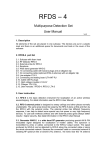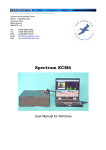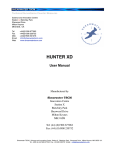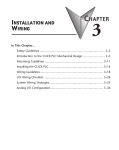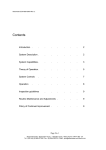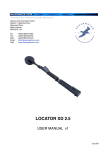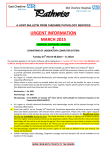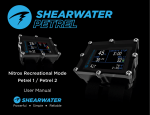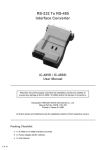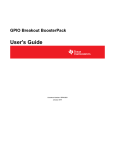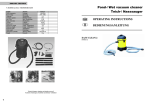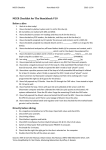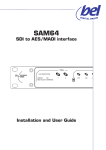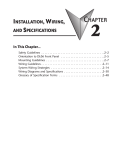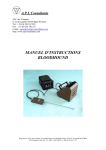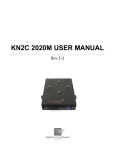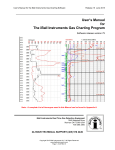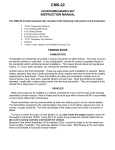Download Bloodhound manual
Transcript
SHEARWATER TSCM Technical Surveillance Counter Measures Science and Innovation Centre Station X, Bletchley Park Sherwood Drive Milton Keynes MK3 6DS, UK Tel Fax Mob Email Web +44(0)1908 677062 +44(0)1908 230732 +44(0)7836 521376 [email protected] www.shearwatertscm.com SHEARWATER TSCM BLOODHOUND User Manual Manufactured by Shearwater TSCM Innovation Centre Station X Bletchley Park Sherwood Drive Milton Keynes MK3 6DS Tel: (44) (0)1908 677062 Fax: (44) (0)1908 230732 Page 1 of 15 SHEARWATER TSCM SHEARWATER TSCM Contents Para Description Page 1 Introduction 2 2 System Description 3 3 System Use 6 4 System Capabilities 8 5 Optimizing the Search Environment 10 6 False Responses 11 7 Search Techniques 12 8 Theory of Operation 13 9 Cable Tracing 14 10 Cable Illumination 14 11 Specifications 14 12 Routine Maintenance and adjustments 14 Page 2 of 15 SHEARWATER TSCM 1 SHEARWATER TSCM Introduction 1.1 The BloodHound Acoustically Stimulated Microphone Detector (A.S.M.D.) is an electronic system for use by Technical Security Inspectors for detecting audio eavesdropping equipment. The system works by detecting the Electric field created whenever a microphone detects sound, and converting that electric field into an audio signal which the BloodHound operator can either listen to, or use to establish an acoustic feedback. 1.2 The BloodHound can be used to detect the following types of espionage attack a) Amplified wired microphone systems - Eavesdropper systems where the target premises is wired directly to the listening post via a twisted pair cabling system. b) Telephone Attacks - Both baseband and attacks using R.F. modulation techniques* c) Radio Microphone Attacks* d) Mains (MOVA) Attacks* e) Tape Recorder Attacks* f) Video camera surveillance** * These kinds of eavesdroppers contain audio amplifiers, the electric fields of which are detectable by the BloodHound system. ** Video cameras and cables emit a distinctive electric field signal which is easily identified by the BloodHound 1.3 In addition to the normal usage, the BloodHound system can be used for the following functions a) General purpose audio amplification. - especially on very weak and/or noisy signals. b) Cable tracing. Page 3 of 15 SHEARWATER TSCM 2. System Description 2.1 The BloodHound system consists of the following components:- 1 x Probe unit 1 x Filter unit (in pouch with waist belt) 1 x Power Amplifier unit 1 x Headset 2 x One metre BNC-BNC Coaxial cables 1 x Two meter BNC-BNC Coaxial cable 1 x Three meter BNC-BNC Coaxial cable 1 x One meter BNC-Crocodile clips cable 1 x One meter BNC-3.5mm jack cable 1 x Walkman style tape player / radio 1 x Set ear defenders 1 x Battery charger (Power Amp) 1 x Stub antenna 1 x Telescopic extension arm 6 x AA size batteries 2 x PP3 batteries 1 x Air puffer 1x Transit case Page 4 of 15 SHEARWATER TSCM 2.2 Probe. This is a small hand held item equipped with a stub antenna at one end, and a B.N.C. Connector at the other end. The probe is the electric field detector of the system, containing high input impedance amplifiers and filtering . The probe requires no batteries, as it is powered from the filter unit by the connection cable. The probe has no controls. 2.3 Filter. The filter is a small box equipped with a belt allowing it to be worn around the operator's waist. The filter is a sophisticated signal processor which removes interference from the signal detected by the probe, providing a signal to the operator's headset, and an output to the system P.A. The filter is provided with the following controls and indicators a) Input socket; a B.N.C. socket which connects to the probe. This accepts signal from the probe, and also provides power to the probe. b) Output socket; a B.N.C. connector allowing connection to the P.A. or recording equipment as appropriate. The output is a constant 1 V p-p. c) Null control. This is a ten turn rotary control which is used to adjust cancellation of A.C. Mains harmonics. d) Null Select (Internal control) A switch which allows selection of mains harmonic null for either 50 Hz or 60 Hz power frequencies. e) VOL control. This rotary control adjusts the output level to the acoustic headset. Note that the filter includes a very effective compressor circuit which constantly adjusts the system gain to ensure that maximum sensitivity is achieved regardless of the system input. f) Headset socket. An acoustic headset socket for attachment of the operator's headset. g) POWER indicator. A green indicator which illuminates when the filter power is on. h) BAT indicator. An Amber indicator which illuminates when the filter batteries are almost exhausted. Page 5 of 15 SHEARWATER TSCM 2.4 Power Amplifier (P.A.) The P.A. unit contains an audio amplifier, a loudspeaker, an audio signal generator, and a rechargeable battery power supply. The P.A. is equipped with the following controls and indicators a) A battery charger input connector. This is a connector to permitt the connection of the battery charger. A Red indicator confirms charger input. b) A Low Battery indicator (amber) c) INPUT socket; a B.N.C. socket for connection to the filter unit, or virtually any other audio input. d) OUTPUT socket; a B.N.C. socket allowing the high power output of the P.A. to be connected to cables for cable tracing, and other functions. e) ON/VOL control; a rotary control which switches the system on, and adjusts the sound level. f) DC ON. A green indicator which illuminates when the P.A. power is on (i.e., when the ON/VOL control is rotated to ON). g) L.S./OUTPUT. h) SWEEP/On/Off. This switch operates the internal audio sweep tone generator. i) SWEEP control; a rotary control which adjusts the sweep rate of the internal s w e e p The power amplifier output is set to either L.S. (the internal loudspeaker) or the OUTPUT socket. tone generator. Page 6 of 15 SHEARWATER TSCM SYSTEM USE 3. 3.1 Basic The BloodHound is one tool in the Technical Security Inspector's tool kit. Its use should be planned in concert with the rest of the Inspector's equipment to maximize the Inspector's chances of discovering a technical attack, and minimizing the chances of alerting the eavesdropper's listening post, which may allow the eavesdropper to instigate effective countermeasures. The BloodHound system can be used to detect eavesdropping microphones in two modes, ACTIVE or PASSIVE. A typical operation may use either passive, active, or both, depending upon the perceived threat and target environment. 3.2 Active mode - Description Active mode uses the probe, the filter, and the P.A., to generate a high sound level corresponding to the audio electric field signals detected by the Probe. If the probe detects the audio signal from an amplified microphone, then the system will go into an acoustic feedback mode similar to that which occurs with a public address amplifier system with the gain set too high. A very characteristic howl is heard. Page 7 of 15 SHEARWATER TSCM 3.3 Active mode - Advantages a) Active mode is the easiest to use mode of operation. b) Quicker than passive mode. c) More sensitive than passive mode in the hands of the average user. 3.4 Active Mode - Disadvantages a) The high sound level produced can alert the listening post that a sweep is in progress. b) The high sound level prevents use in a normal office environment with normal staff present. c) More prone to false responses than Passive mode. 3.5 Passive Mode - Description With Passive mode operation, the P.A. unit is not used at all. The probe is connected to the filter, and the operator uses the filter headset listen for room noises as detected by the eavesdropping microphone system. Page 8 of 15 SHEARWATER TSCM 3.6 Passive Mode - Advantages a) A properly conducted search in passive mode will not alert the listening post that a sweep is in progress, or annoy office staff. b) Less prone to false responses than Active mode. 3.7 Passive mode - Disadvantages a) Takes longer to do properly than active mode. b) A little less sensitive than active mode. 4. System Capabilities 4.1 The capabilities of the BloodHound system depends on the following factors:- a) The level of Electric Field Emissions from the eavesdropper equipment. The BloodHound is typically effective on wired microphone systems which have sufficiently high output to allow use on twisted pair cables. This includes the Eavesdropping microphone systems of most of the world's intelligence services, but not all. The BloodHound is generally not effective on low output microphones using shielded cables. b) The amount of shielding of the eavesdropper equipment. The Electric field emissions can be reduced by the shielding effect of materials between the eavesdropper and the BloodHound probe. Metal screens, concrete, metal window frames, and damp plaster all attenuate the Electric field signal to some degree. c) The local Ambient noise level. At the Audio frequencies at which the BloodHound operates, there is in any environment, naturally occurring Electric field noise, augmented by man made Electrical noise. Page 9 of 15 SHEARWATER TSCM 4.2 Typical Sensitivities The capabilities of the BloodHound to detect an eavesdropper is dependant upon all of the above factors. Listed below are typical detection ranges experienced against actual eavesdroppers in the field. a) Hard wired Amplified microphone system, twisted pair cabling. Zero with cabling buried in deep concrete, to three metres detection range (Passive) with microphone cabling buried in a wooden door frame. b) Radio Microphone - Double Modulated with Noise Masking - 25cm Active, 20cm Passive. c) Micro Cassette recorder - Voice Activated - 25cm Active, 20cm Passive. d) Video Camera - Video signal detectable at 1 Metre (Passive mode). 4.3 Note that all of the above may vary due to differences in the search environment. Note also the great differences in detection range given for the microphone in (a), which truly goes from undetectable to "cannot miss" due only to the method of wiring the microphone's cable back to the listening post. 4.4 The detection of an eavesdropper with the BloodHound requires a diligent search covering all possible locations of concealment in a search location, and thoughtful and conscientious interpretation of the results received. Page 10 of 15 SHEARWATER TSCM 5. Optimizing the Search Environment 5.1 Ambient Noise - Electrical Do whatever is possible to minimize electrical noise, which will reduce the sensitivity of the BloodHound system. While little can be done about naturally occurring noise (most of which comes from the Sun) man made noise can be minimised by switching off fluorescent lights and computer monitors, and anything else which may prove to be a problem. In a domestic setting, it should be noted that Hi-Fi systems and televisions can create considerable electrical noise and are best switched off (but not unplugged). Note that fluorescent lights sometimes generate more noise when they are switched off than when they are on due to leakage current in old building cabling. 5.2 Ambient Noise - Acoustic In contrast to electrical noise, to perform a search with the BloodHound needs as much sound in the search environment as possible. In order for the microphone's Electric Field output to be high, the microphone must be supplied with lots of sound. A radio is a good source of sound, an excuse for which can be found at most locations (News broadcast of relevance, etc). Local noise can be produced by tapping or blowing suspect locations, which will produce high outputs from an adjacent microphone, and the expense of potentially alerting the listening post. The more noise in the search location the better ! Page 11 of 15 SHEARWATER TSCM 6. False Responses 6.1 In addition to the emissions of Clandestine microphone systems, Audio frequency Electric fields corresponding to room noises can be generated by dry insulating materials which are free to vibrate. This includes plastic bags, the plastic covers of telephones and televisions, paper, etc. 6.2 While this effect is most noticeable with the active mode of operation, where the high sound level can cause many surfaces to vibrate, the effect is also noticeable in passive mode when plastic items are tapped lightly. 6.3 Note that while tapping a telephone case may well give a false response with the BloodHound probe held adjacent to the telephone case, if the response is still evident with the probe held adjacent to the telephone cable, the telephone is live to line. User experience is the best way to identify real from false responses. 6.4 It is possible, but unlikely, for adjacent high power broadcast transmitters to be detected by the BloodHound system. Much more likely, however, is the detection of broadcast transmitters by Semiconductor junctions in the search location. These junctions may be due to corroded contacts in electrical boxes, On-Hook Telephones, or corroded wire reinforcement in walls. In all cases, the effect gives rise to the hearing of a radio broadcast in a small localised area. Bear in mind that a switched off eavesdropper may also give this kind of response, so this phenomena deserves at least visual investigation. 6.5 Holding the probe antenna very close to the Filter headphone socket, or close to the P.A. loudspeaker, can cause the initiation of feedback due to audio electric field emissions at these locations. This is useful as a system sensitivity check. Page 12 of 15 SHEARWATER TSCM 7. Search Techniques 7.1 Basic Requirements This section is written assuming the operator is skilled in the performance of Technical Security Inspections. If this is not the case, contact Shearwater 2000 for further information. 7.2 Method In both Active and Passive mode, a search requires that the probe be moved over all surfaces which may conceal an eavesdropper. In Passive mode, the search will be conducted while an innocuous sound source such as a radio is providing noise stimulus for the microphone from the centre of the room. The radio volume should be as high as practical without annoying the neighbours. In active mode, the P.A. will be held facing the surface being swept, or positioned facing the wall a few metres from the wall, connected to the Filter with an extension cable. In both cases, the light level in the search area should be high, to allow the inspector to make full use of another most valuable part of the Technical Security Tool kit, the Inspector's eyes. The Probe antenna is a fixed stub as an extended antenna does not increase sensitivity, and can be prone to overloading from both Mains and local broadcast transmitters. The Probe can be fitted to the telescopic extension arm to aid good coverage with ease. Even if you intend to perform an Active mode sweep, use a passive mode search first. - Even if only on key items like the telephones. A passive search can identify an eaverdropper before the listening post realises that a sweep is in progress. The sound levels produced in an Active mode search are damaging to unprotected ears over a long period of time. The acoustic headset and provided ear protectors accommodate the requirements of a two man Inspection team. USE EAR PROTECTION! Probably the most effective method of obtaining a high output from a microphone is to blow air at it. This method is best accomplished with a photographic puffer (lens cleaner). The effective sound achieved with this approach is very high, but is extremely localised, and free of any possibility of a false response. Beware of Freon pressurised dusting aerosols, the Freon can carry a high electrical charge which creates noise in the BloodHound headset. Page 13 of 15 SHEARWATER TSCM 8. Theory of Operation 8.1 Probe The Probe is a high impedance filter/amplifier. The Probe antenna effectively Capacitively couples the Probe to the eavesdropper. The Probe has a pass band of 1 kHz - 20 kHz, and attenuates low frequency signal at a rate of 40 dB/Decade. The Probe is powered by the Filter via the connecting coax cable, and requires 5 mA @ 24-30 VDC. 8.2 Filter The output of the Probe is passed to a compressor, which optimises the signal level for the rest of the signal processing circuitry. The compressor output is fed to a recursive filter, which is a comb filter with responses every 50 Hz or 60 Hz dependant upon the setting of the internal Null Select switch. The recursive filter removes all harmonics of the Mains. The output of the recursive filter is fed to the output socket, and via the headset volume control, to the Filter acoustic headset socket. The Filter contains a power supply for the Probe which provides 26 VDC at a 600 R source impedance, Positive to the centre of the Coax. 8.3 Power Amplifier The P.A. is capable of 4 W.R.M.S. into a 4 R load, or 12 V p-p output at the B.N.C., at up to 1 Amp R.M.S. The output is short circuit protected. The internal Sweep generator produces a sine wave audio tone swept between approx. 1 to 5 kHz. The sweep rate is variable from Approx. 1 Sweep/Sec to 5 Sweep/sec. by use of the SWEEP RATE control. The P.A. includes a sealed Gel Cell rechargeable battery and charger circuitry, allowing for four hours continual use. Re-charging is automatic whenever the P.A. is connected to mains, and the battery cannot be overcharged. Page 14 of 15 SHEARWATER TSCM Cable Tracing 9. 9.1 The BloodHound system can be used as a cable tracer by connecting the output of the P.A. to the cable to be traced, switching the P.A. to "OUTPUT" and "SWEEP", and following the cable with the Probe/Filter, listening for the characteristic tone of the P.A. audio generator. 9.2 This method of cable tracing differs from most in that due to the low frequency of operation, the signal tends to stay on the desired cable, and not jump to adjacent wires. 9.3 Use the VOL control to adjust the level of signal on the cable to a level suitable for the tracing operation. 10. 10.1 Cable Illumination It is possible to locate and trace concealed cables by induction from a transmit antenna connected to the P.A. output. A suitable Inductive Loop antenna will be available from Shearwater 2000 presently. 11. Specifications 11.1 Physical Dimensions Probe 5cm X 3cm X 11cm Filter 10cm X 6.5cm X 17.5cm P.A. 21cm X 13cm X 16.5cm Routine Maintenance and Adjustments 12. 12.1 The ASMD equipment requires no routine maintenance or adjustment. Should any defect be noted, the equipment should be returned to Shearwater 2000 or a locally appointed maintenance facility of Shearwater 2000 for repair. Page 15 of 15 Designed and manufactured by SHEARWATER TSCM Station X Innovation Centre Bletchley Park Sherwood Drive Milton Keynes MK3 6DS United Kingdom Tel: (IDD 44) (0)1908 677062 Fax: (0)1908 230732 Email: [email protected] Web: www.shearwatertscm.com


















